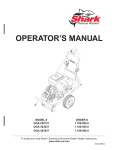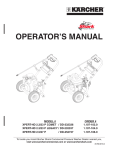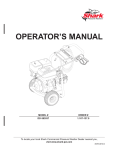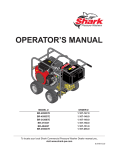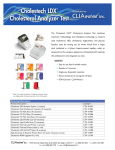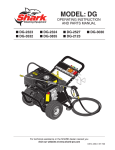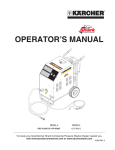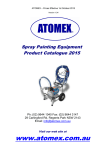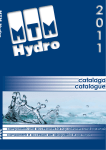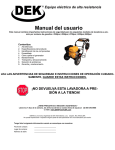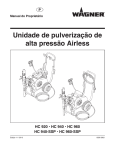Download Shark RG-253037 Operator`s manual
Transcript
OPERATOR’S MANUAL MODEL # RG-253037 ORDER # 1.107-236.0 To locate your local Shark Commercial Pressure Washer Dealer nearest you, visit www.shark-pw.com 9.801-592.0 CONTENTS Important Safety Information.................................................................4-6 Component Identification.......................................................................... 7 Assembly Instructions............................................................................... 8 Operating Instructions.........................................................................9-10 Detergent and General Operating Techniques....................................... 11 Shut Down and Clean-Up....................................................................... 12 Storage................................................................................................... 12 Troubleshooting.................................................................................13-14 Preventive Manteinance......................................................................... 15 Hose and Spray Gun Assembly and Parts list........................................ 16 Oil Change Record................................................................................. 17 Model Number ______________________________ Serial Number ______________________________ Date of Purchase ___________________________ The model and serial numbers will be found on a decal attached to the pressure washer. You should record both serial number and date of purchase and keep in a safe place for future reference. 3 9.801-592.0 • RG • Rev. 02/14 PRESSURE WASHER OPERATOR’S MANUAL INTRODUCTION & IMPORTANT SAFETY INFORMATION Thank you for purchasing this Pressure Washer. WARNING WARNING:This machine exceeds 85 db appropriate ear protection must be worn. We reserve the right to make changes at any time without incurring any obligation. Owner/User Responsibility: The owner and/or user must have an understanding of the manufacturer’s operating instructions and warnings before using this pressure washer. Warning information should be emphasized and understood. If the operator is not fluent in English, the manufacturer’s instructions and warnings shall be read to and discussed with the operator in the operator’s native language by the purchaser/owner, making sure that the operator comprehends its contents. EAR PROTECTION MUST BE WORN WARNING Owner and/or user must study and maintain for future reference the manufacturers’ instructions. The operator must know how to stop the machine quickly and understand the operation of all controls. Never permit anyone to operate the engine without proper instructions. SAVE THESE INSTRUCTIONS USE PROTECTIVE EYE WEAR AND CLOTHING WHEN OPERATING THIS EQUIPMENT. 6. Keep operating area clear of all persons. WARNING This manual should be considered a permanent part of the machine and should remain with it if machine is resold. When ordering parts, please specify model and serial number. Use only identical replacement parts. This machine is to be used only by trained operators. IMPORTANT SAFETY INFORMATION READ OPERATOR’S MANUAL THOROUGHLY PRIOR TO USE. WARNING: To reduce the risk of injury, read operating instructions carefully before using. 1.Read owner's manual thoroughly. Failure to follow instructions could cause malfunction of the machine and result in death, serious bodily injury and/or property damage. 2. Know how to stop the machine and bleed pressure quickly. Be thoroughly familiar with the controls. 3. Stay alert — watch what you are doing. WARNING KEEP WATER SPRAY AWAY FROM ELECTRICAL WIRING. 4 WARNING: Keep wand, hose, and water spray away from electric wiring or fatal electric shock may result. 4. All installations must comply with local codes. Contact your electrician, plumber, utility company or the selling distributor for specific details. WARNING: High pressure spray can cause paint chips or other particles to become airborne and fly at high speeds. To avoid personal injury, eye, hand and foot safety devices must be worn. 5.Eye, hand, and foot protection must be worn when using this equipment. RISK OF EXPLOSION: OPERATE ONLY WHERE OPEN FLAME OR TORCH IS PERMITTED WARNING RISK OF FIRE. DO NOT ADD FUEL WHEN OPERATING MACHINE. WARNING: Flammable liquids can create fumes which can ignite, causing property damage or severe injury. WARNING: Risk of explosion — Operate only where open flame or torch is permitted. WARNING: Risk of fire — Do not add fuel when the product is operating or still hot. WARNING: Do not use gasoline crankcase draining or oil containing gasoline, solvents or alcohol. Doing so will result in fire and/or explosion. WARNING: Risk of fire — Do not Spray flammable liquids. WARNING: This product contains chemicals known to the state of California to cause cancer and birth defects or other reproductive harm. Operation of this equipment may create sparks that can start fires around dry vegetation. A spark arrestor may be required. The operator should contact: Local fire agencies for laws or regulations relating to fire prevention requirements. 7.Allow engine to cool for 1-2 minutes before refueling. If any fuel is spilled, make sure the area is dry before testing the spark plug or starting the engine. (Fire and/or explosion may occur if this is not done.) 9.801-592.0 • RG • Rev. 02/14 WARNING TRIGGER GUN KICKS BACK - HOLD WITH BOTH HANDS WARNING RISK OF INJURY. HOT SURFACES CAN CAUSE BURNS WARNING: Risk of injury. Hot surfaces can cause burns. Use only designated gripping areas of spray gun and wand. Do not place hands or feet on non-insulated areas of the pressure washer. 12. Transport/Repair with fuel tank EMPTY or with fuel shut-off valve OFF. CAUTION: Hot discharge fluid. Do not touch or direct discharge stream at persons. HOT DISCHARGE FLUID: DO NOT TOUCH OR DIRECT DISCHARGE STREAM AT PERSONS. WARNING: This machine produces hot water and must have insulated components attached to protect the operator. 15.Be certain all quick coupler fittings are secured before using pressure washer. WARNING WARNING: Risk of injury. Disconnect battery ground terminal before servicing. 8. When in use , do not place machine near flammable objects as the engine is hot. 9.Oil burning appliances shall be installed only in locations where combustible dusts and flammable gases or vapors are not present. Do not store or use gasoline near this machine. 10. Use No. 1 or No. 2 heating oil (ASTM D306) only. NEVER use gasoline in your fuel oil tank. Gasoline is more combustible than fuel oil and could result in a serious explosion. NEVER use crankcase or waste oil in your burner. Fuel unit malfunction could result from contamination. 11. Do not confuse gasoline and fuel oil tanks. Keep proper fuel in proper tank. WARNING: Grip cleaning wand securely with both hands before starting. Failure to do this could result in injury from a whipping wand. 14.Never make adjustments on machine while in operation. RISK OF INJECTION OR SEVERE INJURY TO PERSONS. KEEP CLEAR OF NOZZLE. WARNING WARNING: High pressure developed by these machines will cause personal injury or equipment damage. Keep clear of nozzle. Use caution when operating. Do not direct discharge stream at people, or severe injury or death will result. OPERATOR’S MANUAL Gasoline engines on mobile or portable equipment shall be refueled: a. outdoors; b. with the engine on the equipment stopped; c. with no source of ignition within 10 feet of the dispensing point; and d. with an allowance made for expansion of the fuel should the equipment be exposed to a higher ambient temperature. In an overfilling situation, additional precautions are necessary to ensure that the situation is handled in a safe manner. PRESSURE WASHER IMPORTANT SAFETY INFORMATION WARNING: Protect machine from freezing. 16. To keep machine in best operating conditions, it is important you protect machine from freezing. Failure to protect PROTECT FROM machine from freezing FREEZING could cause malfunction of the machine and result in death, serious bodily injury, and/or property damage. Follow storage instructions specified in this manual. 17. Inlet water must be clean fresh water and no hotter then 90°F. WARNING WARNING: Risk of asphyxiation. Use this product only in a well ventilated area. 18. Avoid installing machines in small areas or near exhaust fans. Adequate oxRISK OF ASPHYXIATION. USE ygen is needed for comTHIS PRODUCT ONLY IN bustion or dangerous carA WELL VENTILATED AREA. bon monoxide will result. 19.Manufacturer will not be liable for any changes made to our standard machines or any components not purchased from us. 20. The best insurance against an accident is precaution and knowledge of the machine. 13.To reduce the risk of injury, close supervision is necessary when a machine is used near children. Do not allow children to operate the pressure washer. This machine must be attended during operation. 9.801-592.0 • RG • Rev. 02/14 5 PRESSURE WASHER OPERATOR’S MANUAL IMPORTANT SAFETY INFORMATION WARNING: Be extremely careful when using a ladder, scaffolding or any other relatively unstable location. The cleaning area should have adequate slopes and drainage to reduce the possibility of a fall due to slippery RISK OF INJURY FROM FALLS WHEN USING surfaces. LADDER. 21. Do not allow acids, caustic or abrasive fluids to pass through the pump. 22.Never run pump dry or leave spray gun closed longer than 1-2 minutes. 23.Machines with shut-off spray gun should not be operated with the spray gun in the off position for extensive periods of time as this may cause damage to the pump. 24. Protect discharge hose from vehicle traffic and sharp objects. Inspect condition of high pressure hose before using or bodily injury may result. 25. In oil burning models, before disconnecting discharge hose from water outlet, turn burner off and open spray gun to allow water to cool below 100° before stopping the machine. Then open the spray gun to relieve pressure. Failure to properly cool down or maintain the heating coil may result in a steam explosion. 26.Do not overreach or stand on unstable support. Keep good footing and balance at all times. 27. Do not operate this machine when fatigued or under the influence of alcohol, prescription medications, or drugs. 28.In oil burning models, use only kerosene, No. 1 home heating fuel, or diesel. If diesel is used, add a soot remover to every tankful. 29. This pressure washer is equipped with pneumatic tires which may not be fully inflated due to shipping and storage. Please check the air pressure of each tire before use: a. Remove the valve cap from the tire. b. Attach a bicycle pump and inflate the tire to a maximum pressure of 25 PSI. o Note: If a compressor must be used, follow the compressor manufacturer's guidelines to limit the output pressure so as not to exceed 25 PSI. c. Replace the valve cap to the tire valve and tighten firmly. Tire pressure should not exceed 25 PSI. WARNING Follow the maintenance instructions specified in the manual. 6 9.801-592.0 • RG • Rev. 02/14 Garden Hose (not included) PRESSURE WASHER COMPONENT IDENTIFICATION Spray Gun OPERATOR’S MANUAL High Pressure Hose Inlet Screen Trigger Detergent Bucket (not included) Pump Pressure Nozzle Detergent Injector Pump Protector Starter Grip Dipstick Pump — Develops high pressure. Starter Grip— Used for starting the engine manually. Spray Gun — Controls the application of water and detergent onto cleaning surface with trigger device. Includes safety latch. Detergent Injector — Allows you to siphon and mix detergents. Pump Protector — Cycles fresh cool water through pump when recirculating water reaches 140°F. Note: If trigger on spray gun is released for more than 1-2 minutes, water will leak from valve. Warm water will discharge from pump protector onto floor. This system prevents internal pump damage. Wand — Must be connected to the spray gun. High Pressure Hose — Connect one end to water pump discharge nipple and the other end to spray gun. 7 9.801-592.0 • RG • Rev. 02/14 PRESSURE WASHER OPERATOR’S MANUAL ASSEMBLY INSTRUCTIONS Alignment Holes Gun & Hose Hanger Knob Nut Handle Bolt Frame Assy. STEP 1: Attach the handle to the frame of the pressure washer. Note: It may be necessary to move the handle supports from side to side in order to align the handle so it will slide over the frame supports. STEP 2: Insert the carriage bolt through the holes from the back of the unit and attach a knob from the front of the machine. Tighten Knobs with by hand. STEP 3: Attach the Gun & hose hanger and insert nuts from inside. Tighten nuts. Spray Gun Rivets Wand Plastic Plate Safety Latch High Pressure Hose STEP 4: Attach the plastic plate from the top aligned to the four holes placed on top of the handle and insert the rivets through holes of plastic plate. STEP 5: Attach the high pressure STEP 6: Attach wand to spray gun. hose to the spray gun using teflon Tighten wand. tape (not included) on hose threads. Pressure Nozzle Pressure Nozzle Spray Gun/Wand Wand Coupler Wand Coupler High Pressure Hose Coupler Collar STEP 7: Pull spring-loaded collar of the wand coupler back to insert your choice of pressure nozzle. STEP 8: Release the coupler collar and push the nozzle until the collar clicks. Pull the nozzle to make sure it is seated properly. Cold Water Source Garden Hose Pump Water Inlet Garden Hose STEP 10: Connect garden hose to the cold water source. 8 STEP 11: Check inlets filters, remove debris, then connect the garden hose to pump water inlet. CAUTION: Do not run the pump without water or pump damage will result. 9.801-592.0 • RG • Rev. 02/14 STEP 9: Connect the high pressure hose to the discharge nipple. PRESSURE WASHER OPERATING INSTRUCTIONS Oil Dipstick OPERATOR’S MANUAL CAUTION! Engine Shipped without oil. Before starting engine, fill with oil included. Do not over-fill. STEP 1: Check engine oil level. Oil level should be level with the bottom of the oil filler neck. Be sure the machine is level when checking the oil level. (Refer to the engine's operating manual included with machine.) We recommend that the oil be changed after the first 5 hours of use, then once every 50 hours. Note: Improper oil levels will cause low oil sensor to shut off engine. IMPORTANT! Do not run engine with high or low oil levels as this will cause engine damage. Cold Water Source Gas Tank Garden Hose STEP 2: Fill gas tank with unleaded gasoline. Do not use leaded gasoline. STEP 4: Connect garden hose to the cold water source and turn water on completely. Never use hot water. STEP 4: Trigger the spray gun to eliminate trapped air then wait for a steady flow of water to emerge from the spray nozzle. Choke Lever On-Off Switch STEP 5: Open fuel valve. Pull the choke rod to the ON position (on a warm engine, leave the choke rod in the OFF position). STEP 6: Move the engine stop switch to the ON position. 9 9.801-592.0 • RG • Rev. 02/14 OPERATOR’S MANUAL PRESSURE WASHER OPERATING INSTRUCTIONS STEP 9: Pull the starter grip. If the engine fails to start after 2 pulls, squeeze the trigger gun to release pressure and repeat step. Return starter gently. After the engine warms up enough to run smoothly, move choke to run position and throttle to fast position. CAUTION: Small engines may kick back. Do not hold pull starter grip tightly in hand. NOZZLES Safety Latch WARNING! Never replace nozzles without engaging the safety latch on the spray gun trigger. The five color-coded quick connect nozzles provide a wide array of spray widths from 0° to 40° and are easily accessible when placed in the convenient rubber nozzle holder, which is provided on the front of the machine. NOTE: For a more gentle rinse, select the white 40° or green 25° nozzle. To scour the surface, select the yellow 15° or red 0° nozzle. To apply detergent select the black nozzle. 10 9.801-592.0 • RG • Rev. 02/14 WARNING WARNING: Some detergents may be harmful if inhaled or ingested, causing severe nausea, fainting or poisoning. The harmful elements may cause property damage or severe injury. Strainer Detergent Injector Soap Nozzle High Pressure Hose CLEANING TIPS Pre-rinse cleaning surface with fresh water. Place detergent suction tube directly into cleaning solution and apply to surface at low pressure (for best results, limit your work area to sections approximately 6 feet square and always apply detergent from bottom to top). Allow detergent to remain on surface 1-3 minutes. Do not allow detergent to dry on surface. If surface appears to be drying, simply wet down surface with fresh water. If needed, use brush to remove stubborn dirt. Rinse at high pressure from top to bottom in an even sweeping motion keeping the spray nozzle approximately 1 foot from cleaning surface. Use overlapping strokes as you clean and rinse any surface. For best surface cleaning action spray at a slight angle. OPERATOR’S MANUAL STEP 1: Connect detergent injector to discharge nipple on machine. Connect high pressure hose to injector with quick coupler. (Check to make sure locking coupler sleeves are in proper position before applying water pressure). THERMAL PUMP PROTECTION If you run the engine on your pressure washer for 1-2 minutes without pressing the trigger on the spray gun, circulating water in the pump can reach high temperatures. When the water reaches this temperature, the pump protector engages and cools the pump by discharging the warm water onto the ground. This thermal device prevents internal damage to the pump. PRESSURE WASHER DETERGENT AND GENERAL CLEANING TECHNIQUES Recommendations: STEP 2: Use detergent designed specifically for pressure washers. Household detergents could damage the pump. Prepare detergent solution as required by manufacturer. Fill a container with pressure washer detergent. Place filter end of detergent suction tube into detergent container. STEP 3: With safety latch on spray gun engaged, secure black detergent nozzle into quick coupler. NOTE: Detergent cannot be applied using red, yellow, green or white nozzles. STEP 4: With the engine running, pull trigger to operate machine. Liquid detergent is drawn into the machine and mixed with water. Apply detergent to work area. Do not allow detergent to dry on surface. IMPORTANT: You must flush the detergent injection system after each use by placing the suction tubeinto a bucket of clean water, then run the pressure washer in low pressure for 1-2 minutes. • Before cleaning any surface, an inconspicuous area should be cleaned to test spray pattern and distance for maximum cleaning results. • If painted surfaces are peeling or chipping, use extreme caution as pressure washer may remove the loose paint from the surface. • Keep the spray nozzle a safe distance from the surface you plan to clean. High pressure wash a small area, then check the surface for damage. If no damage is found, continue to pressure washing. CAUTION - Never use: • Bleach, chlorine products and other corrosive chemicals • Liquids containing solvents (i.e., paint thinner, gasoline, oils) • Tri-sodium phosphate products • Ammonia products • Acid-based products These chemicals will harm the machine and will damage the surface being cleaned. RINSING It will take a few seconds for the detergent to clear. Apply safety latch to spray gun. Remove black soap nozzle from the quick coupler. Select and install the desired high pressure nozzle. NOTE: You can also stop detergent from flowing by simply removing detergent siphon tube from bottle. 9.801-592.0 • RG • Rev. 02/14 11 OPERATOR’S MANUAL PRESSURE WASHER SHUTTING DOWN AND CLEAN-UP On-Off Switch STEP 1: Remove detergent suction tube from container and insert into one gallon of fresh water. Slide nozzle forward for low pressure or to connect black detergent nozzle. Pull trigger on spray gun and siphon water for one minute. STEP 3: Turn off water supply. STEP 2: Turn off the engine. Pump Water Inlet Discharge Nipple Safety Latch STEP 4: Press trigger to release water pressure. STEP 5: Disconnect the garden hose from the water inlet on the machine. STEP 6: Disconnect the high pressure hose from the high pressure outlet. STEP 7: Engage the spray gun safety lock. STORAGE CAUTION: Always store your pressure washer in a location where the temperature will not fall below 32°F (0°C). The pump in this machine is susceptible to permanent damage if frozen. FREEZE DAMAGE IS NOT COVERED BY WARRANTY. 1. Stop the pressure washer, squeeze spray gun trigger to release pressure. 2. Detach water supply hose and high pressure hose. 3. Turn on the machine for a few seconds, until remaining water exits. Turn engine off immediately. 4. Drain the gas and oil from the engine. 5. Do not allow high pressure hose to become kinked. 6. Store the machine and accessories in a room which does not reach freezing temperatures. CAUTION: Failure to follow the above directions will result in damage to your pressure washer. When the pressure washer is not being operated or is being stored for more than one month, follow these instructions: 12 1. Replenish engine oil to upper level. 2. Drain gasoline from fuel tank, fuel line, fuel valve and carburetor. 3.Pour about one teaspoon of engine oil through the spark plug hole, pull the starter grip several times and replace the plug. Then pull the starter grip slowly until you feel increased pressure which indicates the piston is on its compression stroke and leave it in that position. This closes both the intake and exhaust valves to prevent rusting of cylinder. 4.Cover pressure washer and store in a clean, dry place that is well ventilated away from open flame or sparks. NOTE: The use of a fuel additive, such as STA-BIL®, or an equivalent, will minimize the formulation of fuel deposits during shortage. Such additives may be added to the gasoline in the fuel tank of the engine, or to gasoline in a storage container. After Extended Storage CAUTION: Prior to restarting, thaw out any possible ice from pressure washer hoses, spray gun or wand. Engine Maintenance During the winter months, rare atmospheric conditions may develop which will cause an icing condition in the carburetor. If this develops, the engine may run rough, lose power and may stall. This temporary condition can be overcome by deflecting some of the hot air from the engine over the carburetor area. NOTE: Refer to the engine manufacturer's manual for service and maintenance of the engine. 9.801-592.0 • RG • Rev. 02/14 PROBLEM POSSIBLE CAUSE SOLUTION LOW OPERATING PRESSURE Insufficient water supply. Closed faucet. Inlet hose kinked Use larger garden hose; clean inlet water screen. Open faucet. Clogged inlet hose strainer Check plumbing system for leaks. Retape leaks with teflon tape. Faulty or mis-adjusted unloader valve Adjust unloader for proper pressure. Install repair kit when needed. Call local distributor. Worn packing in pump Call Dealer Customer Support. Machine has been stored in freezing temperatures Thaw out machine completely, including hose, spray gun and wand. Slow engine RPM Call local distributor. Worn or dirty pump valves Call local distributor. Nozzle is obstructed Blow out or remove debris with fine needle. Pump sucking air, inlet hose leaking Check that all hoses and fittings are airtight. Turn off machine and trigger spray gun until a steady flow of water emerges through the nozzle. Insufficient water supply Turn water on full force. Check garden hose for kinks, leaks or blockage. PRESSURE LOW AFTER PERIOD OF NORMAL USE Nozzle worn Replace nozzle. Unloader valve worn Replace unloader valve. ENGINE WILL NOT START OR STOPS WHILE OPERATING Low oil shutdown Fill engine with oil. Out of gas Fill fuel tank. Water in gasoline Drain gas tank; fill with clean fuel. ENGINE IS OVERLOADED Nozzle partially blocked Clean nozzle. Excessive pressure from high engine RPM Adjust engine throttle to lower RPM. WATER OR OIL LEAKING FROM BOTTOM OF PUMP A small amount of leaking is normal If excessive leaking occurs, Call local distributor. FLUCTUATING PRESSURE PRESSURE WASHER Troubleshooting Guide TROUBLESHOOTING 13 9.801-592.0 • RG • Rev. 02/14 PRESSURE WASHER Troubleshooting Guide TROUBLESHOOTING PROBLEM POSSIBLE CAUSE SOLUTION ENGINE OPERATES FOR 15 MINUTES THEN STOPS Not enough gas or engine oil Fill tank with gas. Check oil level. Vapor lock developed by heat of day Keep gas tank full to avoid vapor locking. Obstruction in fuel filter Clean or replace fuel filter. ENGINE LACKS POWER Dirty air filter Replace air filter. ENGINE FALTERS Choke is opened too soon Move choke to halfway position until engine runs smoothly. WATER DRIPPING Piston packing worn FROM UNDER PUMP O-Ring plunger retainer worn Call local distributor. Call local distributor. Cracked piston Call local distributor. OIL DRIPPING Oil seal worn or damaged Call local distributor. WATER LEAKING FROM PUMP PROTECTOR Spray gun closed with machine running 5 minutes or longer Open spray gun or turn off machine. Excess water supply pressure Place a pressure regulator at end of 50' garden hose. NO DETERGENT Detergent suction tube not properly connected to machine Check connection. Detergent is too thick Dilute detergent. For best results, use manufacturers detergent. Detergent filter valve is at lowest setting Set detergent filter valve to a higher setting. Filter on detergent suction tube is clogged Run warm water through filter to remove debris. Damaged or clogged detergent suction tube Remove obstruction or replace detergent suction tube. A high pressure nozzle is attached. Replace with black detergent nozzle. Discharge nozzle is obstructed Blow out or remove debris with fine needle. GARDEN HOSE CONNECTION LEAKS Loose fittings Tighten fittings. Missing/worn rubber washer Insert new washer. SPRAY WAND LEAKS Spray wand not properly attached Slide the spray wand into the gun. Turn the wand collar clockwise onto the spray gun threads until tight. Broken o-ring Call local distributor and order an o-ring. Pump is sucking air Check that hoses and fittings are air tight. Turn off machine and purge pump by squeezing trigger gun until a steady flow of water emerges through nozzle. PUMP IS NOISY 14 9.801-592.0 • RG • Rev. 02/14 This pressure washer was produced with the best available materials and quality craftsmanship. However, you as the owner have certain responsibilities for the correct care of the equipment. Attention to regular preventative maintenance procedures will assist in preserving the performance of your equipment. Contact your dealer for maintenance. Regular preventative maintenance will add many hours to the life of your pressure washer. Perform maintenance more often under severe conditions. Check engine oil level before first use of your new pressure washer. MAINTENANCE SCHEDULE Engine Oil Air Cleaner/Filter Inspect Daily Change First month or 20 hours. Every 100 hours or every 6 months after first month Filter Every 50 hours Inspect Every 50 hours Clean Monthly Engine Fuel Filter 500 hours or 6 months Spark Plug Maintenance 300 hours or annually Clean Fuel Tank(s) Annually Replace Fuel Lines Annually Replace High Pressure Nozzle Every 6 months Replace Quick O-Rings As needed Clean Water Screen/Filter Weekly Replace HP Hose Annually (if there are any signs of wear) PRESSURE WASHER Troubleshooting Guide PREVENTATIVE MAINTENANCE 15 9.801-592.0 • RG • Rev. 02/14 PRESSURE WASHER HOSE & SPRAY GUN ASSEMBLY 2 OPERATOR’S MANUAL 3 1 4 HOSE & SPRAY GUN ASSEMBLY PARTS LIST ITEM PART NO. DESCRIPTION 1 8.753-423.0 HOSE, HP DN6 25 FT, 3600PSI M22 2 AL BIT101 TRIGGER GUN 9.112-012.0 QTY 1 1 3 9.112-533.0 Lance-AL Quick Connect-Male 3000 psi1 4 9.104-024.0 QUICK CONNECT NOZZLE KIT (030)1 16 9.801-592.0 • RG • Rev. 02/14 Check engine oil level before first use of your new pressure washer. Date Oil Changed Month/Day/Year Estimated Operating Hours Since Last Oil Change Date Oil Changed Month/Day/Year Estimated Operating Hours Since Last Oil Change PRESSURE WASHER OIL CHANGE RECORD OPERATOR’S MANUAL 17 9.801-592.0 • RG • Rev. 02/14 ® www.shark-pw.com Form #9.801-592.0 • RG • Revised 02/14 • Printed in U.S.A. or Mexico



















